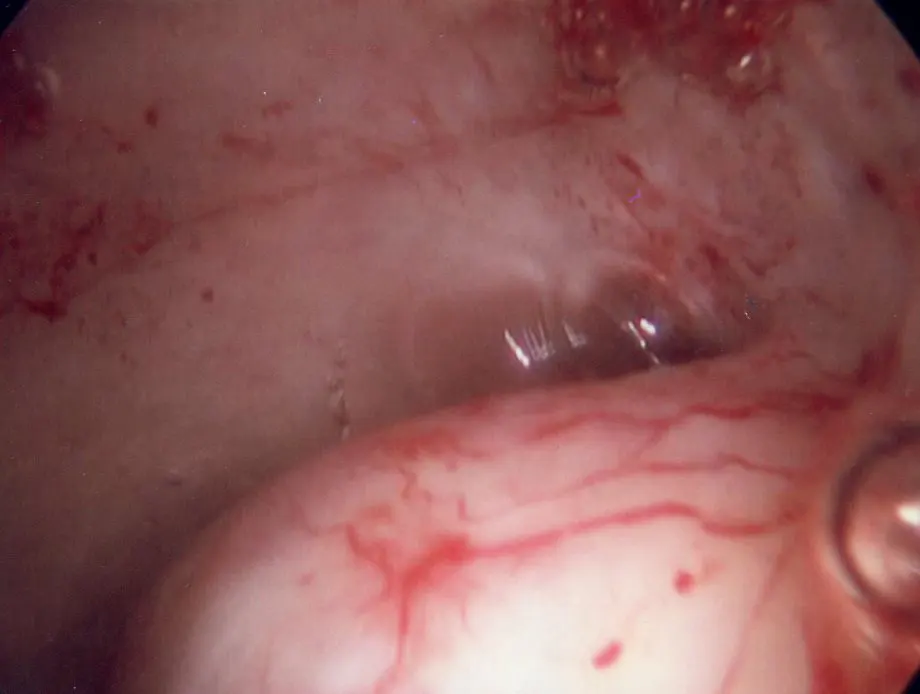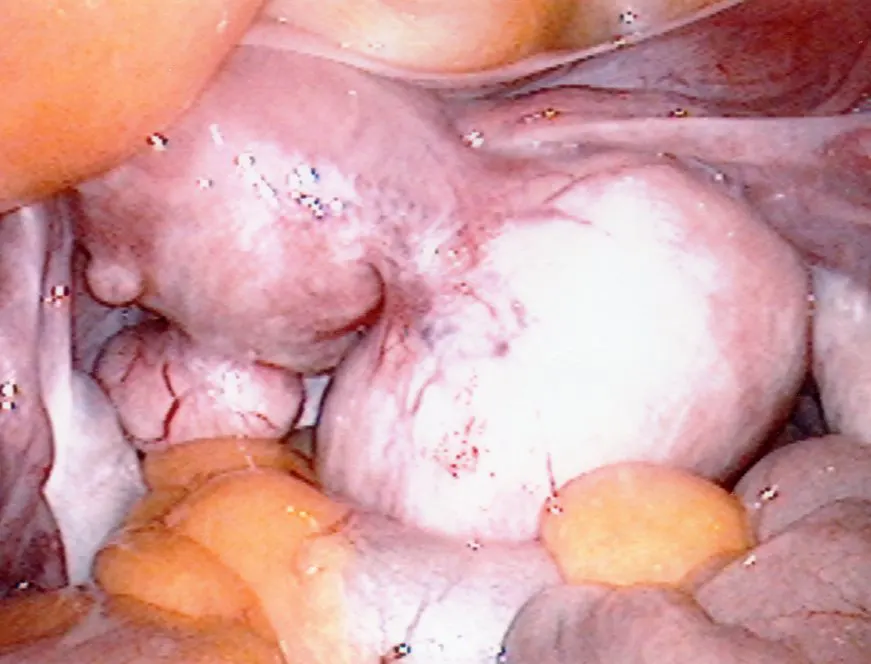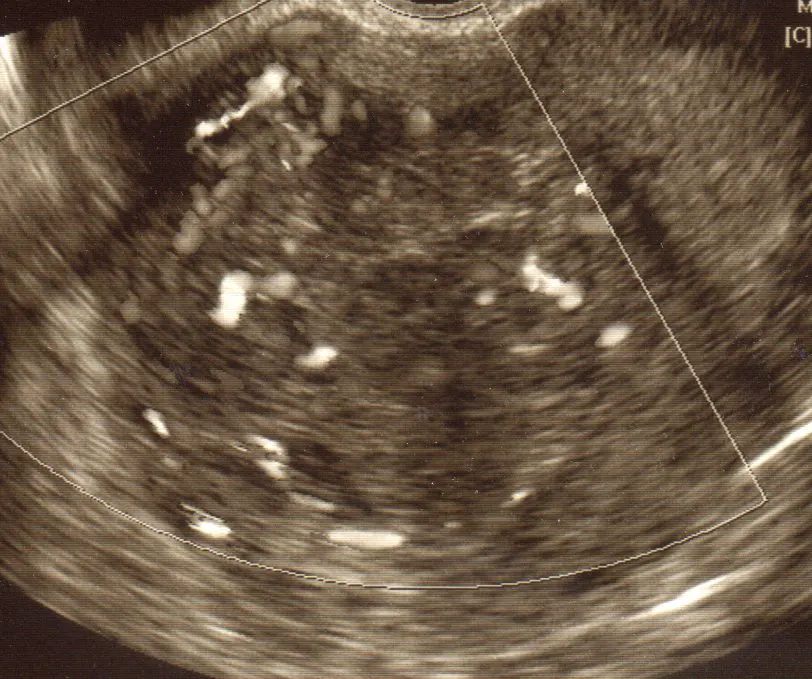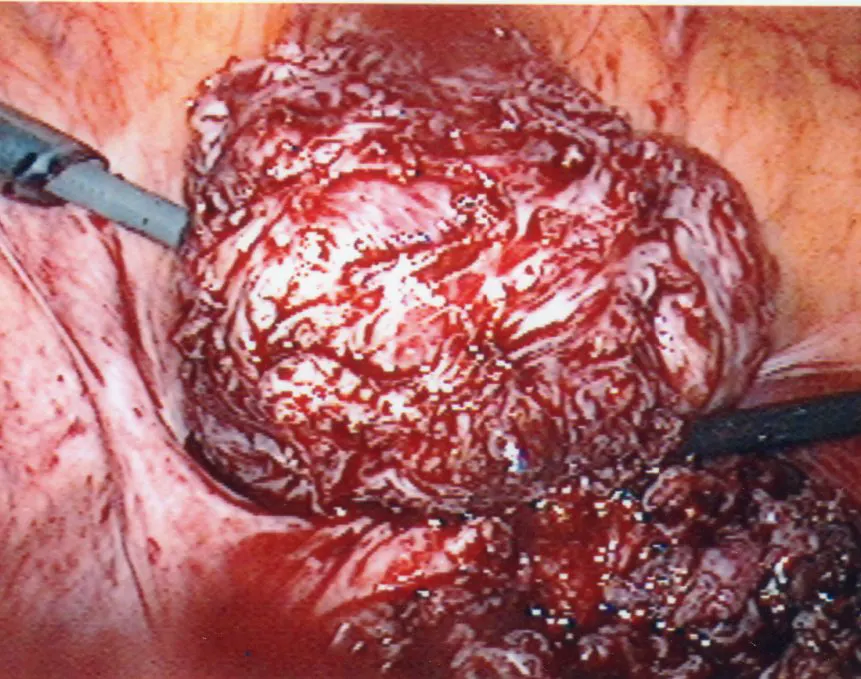
What are Uterine Fibroids?
Uterine fibroids (also called myomas or leiomyomas) are benign (non-cancerous) tumors in the uterus or womb. The uterus is made of muscle. Fibroids originated from the smooth muscle cells in the wall of the uterus. Fibroids can grow as a single growth or in clusters (or groups). Their size can vary from small (less than an inch) to very large (greater than eight inches across). They can be completely embedded in the wall of the uterus, protrude inward into the uterine cavity, or bulge outside of the exterior surface of the uterus.
How Common is Uterine Fibroid?
Fibroids are very common. It is estimated that eight out of ten African-American women and seven out of ten Caucasian women have uterine fibroids by the time they reach menopause. However most uterine fibroids do not cause symptoms and do not require treatment.
What Causes Uterine Fibroids?
The cause of fibroids is unknown. Research has shown that all the cells in a single fibroid are derived from a genetically altered single muscle cell in the wall of the uterus. When this abnormal cell multiplies rapidly to form a tumor, a uterine fibroid is formed. Multiple fibroids within the same uterus are not genetically related, each tumor arises independently.
Fibroid seems to respond to female sex hormones, estrogen and progesterone. Estrogen stimulates the growth of fibroids. After menopause, when estrogen levels are low, fibroids frequently shrink. Progesterone can also influence the growth of uterine fibroid, which explains why some fibroids grow during pregnancy.
Genetics seems to play a role in the formation of uterine fibroids. There is a 2.5 fold increased risk of developing fibroids in first-degree relatives of women with uterine fibroids. Uterine fibroids are 2-3 times more common in black women compared with white, Hispanic, and Asian women.
Smoking decreases the risk (presumably by decreasing estrogen levels) while obesity increases the risk (presumably by increasing estrogen levels) of uterine fibroid. On the other hand, the use of birth control pill is not associated with increased risk of uterine fibroids.
Can Fibroids be Cancerous?
A cancerous (malignant) uterine fibroid is called leiomyosarcoma. The overall risk of leiomyosarcoma in patients with uterine fibroids is very low, less than 1 in 300. It is not clear whether the leiomyosarcoma arises independently or from uterine fibroids.
Do Uterine Fibroids Get Worse with Time?
Some fibroids grow with time and others shrink. Fibroids can also have growth spurts when they grow quickly over a period of time.
Where are Fibroids Found?
Fibroids are usually found in and around the body of the uterus, but sometimes they may be found in the cervix (neck of the uterus). Rarely, fibroids may be found outside the uterine.
Depending on the location within the uterus, fibroids can be divided into three categories:
- Subserosal:(55%) located in the outer wall of the uterus and protrudes outside of the uterus,
- Intramural:(40%) located in the muscular layers of the uterine wall
- Submucosal: (5%) protrudes into the uterine cavity.
Other descriptive terms for fibroids include
- Pedunculated: a fibroid connected to the uterus through a stalk (pedicle). The fibroid can grow outward into the abdomen or into the uterine cavity. Sometimes, the stalk can get twisted and cause severe pain
- Ligamentous: a fibroid growing sideways between the layers of the broad ligament (a broad band of fibrous connective tissue on the sides of the uterus).
Photos, Left to Right: Submucosal Fibroid inside the uterine cavity; Pedunculated Fibroid; Ultrasound of Intramural Fibroid; Same Fibroid Removed by Laparoscopic Myomectomy
How are Uterine Fibroids Diagnosed?
Pelvic examination
Uterine fibroids are often diagnosed by pelvic examination. The fibroids may be determined by assessing the shape and size of the uterus. Sometimes a pelvic examination alone may not be enough to distinguish a fibroid from an ovarian mass adjacent to the uterus. Further imaging studies, such as an ultrasound examination may be necessary to confirm the finding of a pelvic examination.
Ultrasound
Ultrasound uses high frequency sound waves to create a picture of the pelvic organs. Depending on the size and location of the fibroids, both abdominal and vaginal ultrasounds may be used to best examine the fibroids.
Sonohysterogram
Sonohysterogram is most useful to identify whether a fibroid protrudes into the uterine cavity (submucosal fibroid). In this ultrasound procedure, a small amount of fluid is placed inside the uterus through a thin plastic tube (catheter). Simultaneous ultrasound examination of the uterine cavity is carried out. A fibroid that protrudes into the cavity is easily spotted against the background of fluid in the uterine cavity.
Magnetic resonance imaging (MRI)
On some occasions and especially when uterine artery embolization is considered, an MRI of the uterus will be performed. MRI does not use ionizing radiation like X-rays or computed tomography (CT). An MRI scanner uses a combination of electromagnetic field and radio frequency to allow a construction of an image of the scanned area of the body.
What are the Symptoms of Uterine Fibroids?
Increased menstrual bleeding
Fibroids can increase the amount and number of days of menstrual bleeding. Women who have excessive menstrual bleeding are at risk for low blood count (iron deficiency anemia) and as a result fatigue and loss of stamina.
Irregular bleeding
Uterine fibroids that protrude inside the uterine cavity not only can cause increased menstrual bleeding but irregular bleeding as well.
Pelvic pressure and pain
Large uterine fibroids can compress on the bladder, giving the urge to urinate frequently. Fibroids that arise from the back wall of the uterus can compress against the rectum, causing constipation. Occasionally a fibroid can be so big it obstructs the urine flow from the kidney to the bladder, causing urine to backup in the kidney (hydronephrosis). If the blockage of urine flow is not relieved promptly, permanent kidney damage can result.
When a fibroid grows so big that it outstrips its blood supply, the center part of the tumor may degenerate (necrosis). When this happens, severe pain will result.
Problems with fertility and pregnancy
See: Does uterine fibroid cause infertility?
See: What happens to uterine fibroid during pregnancy?
Does Uterine Fibroid Cause Infertility?
Most women with fibroids are able to become pregnant without a problem. For this reason, it is important to go through a basic infertility evaluation before concluding the fibroids are responsible for the problem.
Certain fibroids can cause trouble becoming pregnant or miscarriage. The critical factors are the location and size of the fibroids. If the fibroid distorts the uterine cavity (the inside of the uterus), it may affect implantation. When the fibroid obstructs the fallopian tube, cervical canal or uterine cavity, it may block the migration of the sperm.
What Happens to Uterine Fibroid During Pregnancy?
Most fibroids do not grow during pregnancy. Some fibroids may grow during pregnancy, usually in the first trimester, and most regress in size after pregnancy. Depending on their size, location and growth rate during pregnancy, they may affect the baby’s presentation at the time of delivery, or increase the risk of miscarriage, premature delivery and risk of a cesarean section.
Should I have my Fibroids Removed Before I Attempt to Conceive?
Most women with fibroids have a completely normal pregnancy without complications. However women with a large fibroid (greater than 5 to 6 cm) may have an increased risk of obstetrical complications. Whether a fibroid should be removed before pregnancy depends on the location, size and number of fibroids as well as the particular individual’s past obstetrical history and current health history.
Medical Treatments for Uterine Fibroids
Medical treatment is often used to reduce the menstrual flow and pain. Sometimes medical treatment may be recommended before surgical treatment.
Hormonal birth control
Any one of the hormonal methods of birth control reduces menstrual bleeding, as well as menstrual cramp or pain. These include birth control pill, skin patch, vaginal ring, shot, hormonal IUD and implant. It may take up to three months for you to see a response.
Anti-fibrinolytic
Tranexamic acid (Lysteda®) is an anti-fibrinolytic medication available in the U.S. It does not shrink fibroids or correct anemia. It works by helping blood clot. The advantage of anti-fibrinolytic medication is it slows bleeding quickly, within 2-3 hours. It has no impact on your ability to get pregnant and you only need to take them during your period.
However, you should not take hormonal birth control and anti-fibrinolytic medicine together because they increase your risk of blood clots, stroke, and heart attack.
Gonadotropin releasing hormone agonist (GnRH agonist)
GnRH agonists (e.g. Leuprolide acetate) work by “turning off” the ovaries, causing a temporary and reversible menopause. They are given as an injection every one to three months. They are very effective in temporarily shrink uterine fibroids and stop menstrural bleeding. Side effects include hot flashes, mood swing, irritability, joint pain and muscle ache. They cannot be used for longer than six months in a row due to risk of thinning bones (osteoporosis).
GnRH agonists are used in selected patients for 3-6 months before surgical removal of fibroid. If the woman is suffering from anemia from uterine fibroid, the 3-6 months of time can allow her body to correct the anemia. When the fibroids are very large, pre-treatment with GnRH agonists allows the fibroids to shrink, making the surgical removal easier with less operative time and blood loss.
Non-steroidal anti-inflammatory medication (NSAIDs)
NSAIDs such as ibuprofen and naproxen are very effective to relieve menstrual cramps. They are available without a prescription. Side effects are few when you take them only during the menstrual period. However, NSAIDs do not reduce menstrual bleeding.
Surgical Treatments for Uterine Fibroids
With few exceptions, surgical treatment is more effective in relieving symptomatic uterine fibroids.
Myomectomy
Myomectomy is the surgical removal of fibroids while leaving the uterus in place. Because a woman preserves her uterus, she retains her ability to become pregnant. It is an effective treatment to reduce both bleeding, pain and pressure from uterine fibroids.
Fibroids do not re-grow after myomectomy, but new fibroids may develop. The 5-year recurrence rate after abdominal myomectomy for a single uterine fibroid is about 10% and 25% with multiple fibroids. The 10-year recurrence rate after single myomectomy is 27%. For this reason, myomectomy is not the best choice for women who no longer wish to have future pregnancies.
There are several ways to perform myomectomy. The “best” way depends on the location, size and number of fibroid in the uterus.
- abdominal myomectomy: an incision (cut) is made is the lower abdomen to remove the fibroids.
- laparoscopic or robotic myomectomy: several small incisions are made in the stomach to allow small instruments and a camera (laparoscope) to remove the fibroids. Robotic myomectomy is a variation of laparoscopic myomectomy where the surgery is assisted with a surgical robot.
- hysteroscopic myomectomy: this procedure is specific and effective for fibroids located inside the cavity of the uterus (submucosal fibroids). Small instruments and a camera (hysteroscope) are inserted into the uterine cavity through the cervix to remove the fibroids. Recovery is rapid because there is no incision on the stomach.
Endometrial ablation
Endometrial ablation destroys the lining of the uterus. The treatment does not shrink the fibroids(s) but can help reduce heavy menstrual bleeding caused by fibroids (smaller than 3 centimeters). There are several ways to perform endometrial ablation.
Endometrial ablation is not a birth control. You need to use some form of birth control to prevent pregnancy after ablation. Women who do get pregnant after ablation are more likely to have an abnormal pregnancy.
Hysterectomy
Hysterectomy is the removal of the uterus. The ovaries may or may not be removed. Hysterectomy is a permanent treatment that cures heavy menstrual bleeding, and the pressure and pain symptoms of fibroids. It is done when medical treatments have not worked or are not possible or the fibroids are very large. A woman is no longer able to become pregnant after having a hysterectomy.
Uterine artery embolization
In uterine artery embolization (also called UAE or uterine fibroid embolization, UFE), tiny particles (about the size of grains of sand) are injected into the blood vessels that lead to the uterus. The particles cut off the blood flow to the fibroid and cause it to shrink. However, the procedure is not recommended for large fibroids, submucosal fibroids or pedunculated fibroids.
Embolization is not recommended for women who desire to retain their fertility. When compared with myomectomy, embolization is associated with a higher rate of infertility and miscarriage.
Magnetic resonance guided focused ultrasound
This is the newest fibroid treatment option. A magnetic resonance mapping for heat is used to locate the uterine fibroids and high energy ultrasound is delivered to the fibroids to destroy them with instant necrosis. Injury to the skin and normal tissues in the pathway of the high-energy ultrasound are potential side effects. The technique is so new that safety and efficacy of this procedure remains to be established.
What Treatment is Right for Me?
There are many treatment options for fibroids. Which treatment is right for you depend on a number of factors including fibroid-related symptoms, the size and location of your fibroids, your desire to have a pregnancy in the future, any previous abdominal or pelvic surgery, and any other coexisting medical disease.
If you are having heavy menstrual bleeding, you can first try medical treatments such as hormonal birth control methods, non-steroidal anti-inflammatory drugs (NSAIDs) or anti-fibrinolytic medication.
For some women who no longer desire future pregnancies, endometrial ablation is an option to reduce menstrual bleeding. But endometrial ablation will not eliminate the symptoms due to the pressure of an enlarged uterus. If your fibroid symptoms are primarily related to the size of the fibroids, you can also consider uterine fibroid embolization, myomectomy, hysterectomy or focused ultrasound procedure.
If you have difficulty getting pregnant and your fibroid is determined to be the cause of your infertility, myomectomy is the treatment of choice. But before you undergo myomectomy for infertility, be sure you have gone through a basic infertility evaluation to rule out other causes of infertility.
References
- Uterine Fibroids by the American College of Obstetricians and Gynecologists
- What are Fibroids? By ASRM
- Uterine Fibroids (Beyond the Basics) by Uptodate
- Fibroids and Fertility by ASRM
- Treatment of Uterine Fibroids by ASRM
- Endometrial Ablation by ASRM
- Endometrial Ablation by the American College of Obstetricians and Gynecologists
- Uterine Fibroid Embolization
- Uterine Artery Embolization by the U.S. National Library of Medicine
Schedule a Consultation
Contact Us
If you are experiencing a medical emergency, call 911 or go to the nearest emergency room.
We understand you may have a lot of questions. Additionally, each couple or individual has a unique set of circumstances. To this end, the best way to get answers for your situation is a face-to-face consultation with our physician.
Schedule a Consultation
Contact Us
If you are experiencing a medical emergency, call 911 or go to the nearest emergency room.
We understand you may have a lot of questions. Additionally, each couple or individual has a unique set of circumstances. To this end, the best way to get answers for your situation is a face-to-face consultation with our physician.















